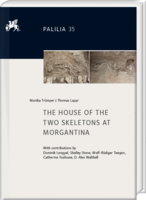|
weitere Titel zum Thema:
Download:
The House of the Two Skeletons is located in a quarter at the western border of the Hellenistic city of Morgantina in Sicily. It was partially investigated in 1971 and 2004/05, and fully excavated from 2014 to 2016. Built around 250 BC as a simple and modestly decorated courtyard house, it occupied a squarish lot with a surface area of 389 m2 and included 20 rooms. During its use for some 50–60 years, the house was remodeled four times. The building was split into two separate courtyard houses in Phase 3 before 211 BC, when the Romans conquered Morgantina. At the end of this phase, two adult women were buried in two separate corner rooms of the house, and their skeletons gave this house its modern name. The women were most likely buried in haste during the tumultuous years that preceded the final conquest of the city, sometime between 214 and 211 BC. After 211 BC, the house was briefly and partially used for modest residential purposes and industrial activities that can no longer be specified.
This book presents the archaeological evidence of the House of the Two Skeletons in a contextualized and comprehensive manner. All rooms are described and assessed one after another, including the architecture, the stratigraphy, and the finds, followed by an interpretation that outlines the phasing scheme and possible function of a room. Thematic discussions are dedicated to significant features, such as the construction materials and techniques, the water management, kitchens, platforms, evidence of domestic cult, metal finds and coins, and the skeletons. Finally, a concluding narrative outlines the development and function of the House of the Two Skeletons and assesses it in the local urban and regional Sicilian context. |






